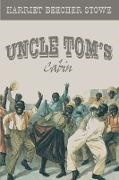Share
Fr. 26.30
Harriet Beecher Stowe
Uncle Tom's Cabin
English · Paperback / Softback
Shipping usually within 2 to 3 weeks (title will be printed to order)
Description
This is one of those books that everybody has heard about but few people these days have actually read. It deserves to be read - not simply because it is the basis for symbols so deeply ingrained in American culture that we no longer realize their source, nor because it is one of the bestselling books of all time. This is a book that changed history. Harriet Beecher Stowe was appalled by
slavery, and she took one of the few options open to nineteenth century women who wanted to affect public opinion: she wrote a novel, a huge, enthralling narrative that claimed the heart, soul, and politics of pre-Civil War Americans. It is unabashed propaganda and overtly moralistic, an attempt to make whites - North and South - see slaves as mothers, fathers, and people with (Christian) souls. In a time when women might see the majority of their children die, Harriet Beecher Stowe portrays beautiful Eliza fleeing slavery to protect her son. In a time when many whites claimed slavery had "good effects" on blacks, Uncle Tom's Cabin paints pictures of three plantations, each worse than the other, where even the best plantation leaves a slave at the mercy of fate or debt. By twentieth-century standards, her propaganda verges on melodrama, and it is clear that even while arguing for the abolition of slavery she did not rise above her own racism. Yet her questions remain penetrating even today: "Is man ever a creature to be trusted with wholly irresponsible power?
About the author
Harriet Elisabeth Beecher Stowe (1811 - 1896) was an American abolitionist and author. She came from the Beecher family, a famous religious family and is best known for her novel Uncle Tom's Cabin (1852), which depicts the harsh conditions for enslaved African Americans. The book reached millions as a novel and play and became influential in the United States and Great Britain, energizing anti-slavery forces in the American North, while provoking widespread anger in the South. Stowe wrote 30 books, including novels, three travel memoirs and collections of articles and letters. She was influential for both her writings and her public stances on social issues of the day. In 1832, at the age of 21, Harriet Beecher moved to Cincinnati. There, she also joined the Semi-Colon Club, a literary salon and social club whose members included the Beecher sisters, Caroline Lee Hentz, Salmon P. Chase (future governor of the state and Secretary of Treasury under President Lincoln), Emily Blackwell and others. Cincinnati's trade and shipping business on the Ohio River was booming, drawing numerous migrants from different parts of the country, including many free blacks, as well as Irish immigrants who worked on the state's canals and railroads. Areas of the city had been wrecked in the Cincinnati riots of 1829, when ethnic Irish attacked blacks, trying to push competitors out of the city. Beecher met a number of African Americans who had suffered in those attacks and their experience contributed to her later writing about slavery.
It was in the literary club that she met Calvin Ellis Stowe, a widower who was a professor at the seminary. The two married on January 6, 1836. He was an ardent critic of slavery and the Stowes supported the Underground Railroad, temporarily housing several fugitive slaves in their home. Most slaves continued north to secure freedom in Canada. The Stowes had seven children together, including twin daughters. n 1850, Congress passed the Fugitive Slave Law, prohibiting assistance to fugitives and strengthening sanctions even in free states. At the time, Stowe had moved with her family to Brunswick, Maine, where her husband was now teaching at Bowdoin College.
Shortly after in June, 1851, when she was 40, the first installment of her Uncle Tom's Cabin was published in serial form in the newspaper The National Era. She originally used the subtitle "The Man That Was A Thing", but it was soon changed to "Life Among the Lowly". Installments were published weekly from June 5, 1851, to April 1, 1852. For the newspaper serialization of her novel, Stowe was paid $400. Uncle Tom's Cabin was published in book form on March 20, 1852, by John P. Jewett with an initial print run of 5,000 copies. In less than a year, the book sold an unprecedented 300,000 copies. By December, as sales began to wane, Jewett issued an inexpensive edition at 37¿ cents each to stimulate sales. According to Daniel R. Lincoln, the goal of the book was to educate northerners on the realistic horrors of the things that were happening in the south. The other purpose was to try to make people in the south feel more empathetic towards the people they were forcing into slavery.
Product details
| Authors | Harriet Beecher Stowe |
| Publisher | www.bnpublishing.net |
| Languages | English |
| Product format | Paperback / Softback |
| Released | 01.07.2013 |
| EAN | 9781607966166 |
| ISBN | 978-1-60796-616-6 |
| No. of pages | 386 |
| Dimensions | 152 mm x 229 mm x 23 mm |
| Weight | 625 g |
| Subject |
Fiction
> Narrative literature
|
Customer reviews
No reviews have been written for this item yet. Write the first review and be helpful to other users when they decide on a purchase.
Write a review
Thumbs up or thumbs down? Write your own review.

